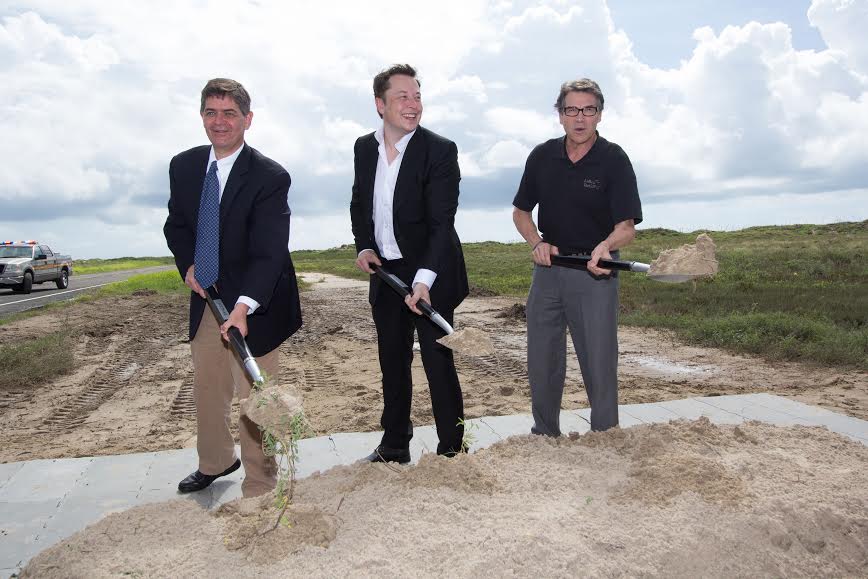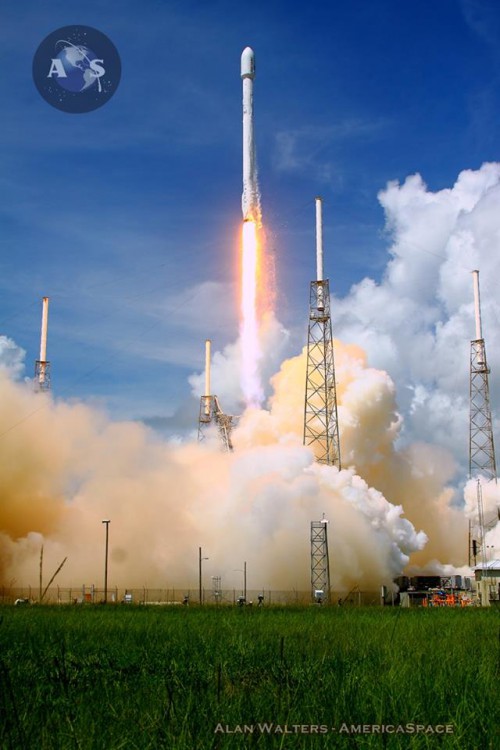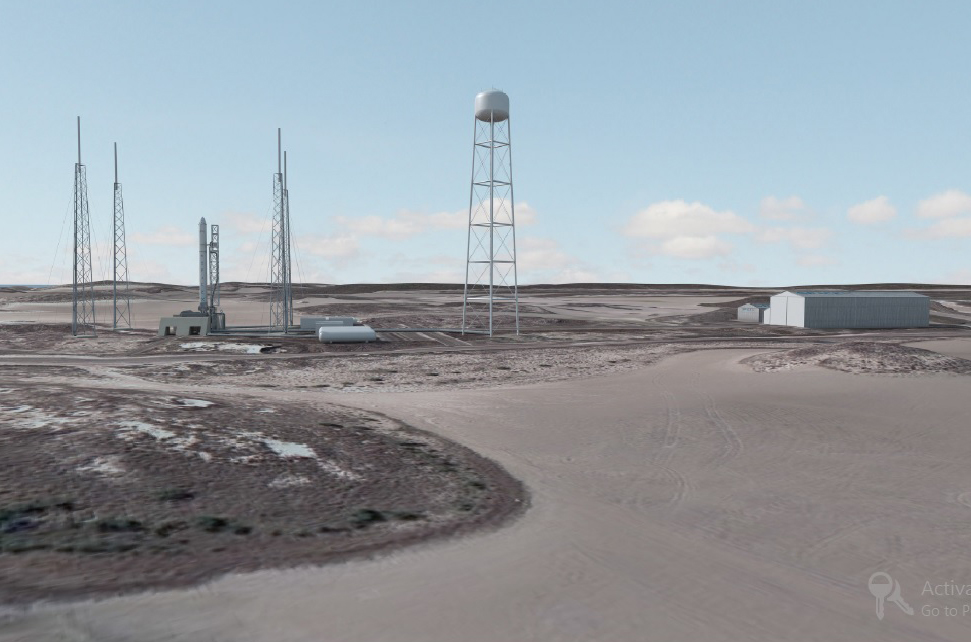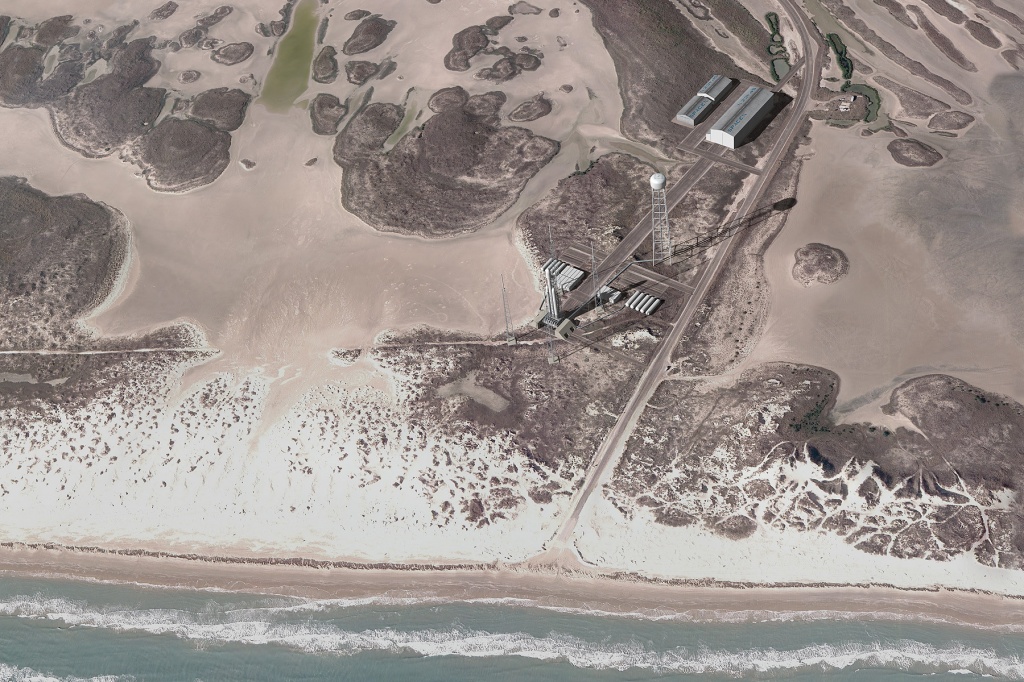
In the last two weeks SpaceX has accomplished quite a bit, having earned a commercial crew contract to launch NASA astronauts to the International Space Station (ISS) and having carried out their fourth dedicated ISS resupply mission (mission CRS-4). It was just last month that the Hawthorne, Calif.-based company officially announced their plans to build the world’s first commercial space launch site at Boca Chica Beach in Brownsville, Texas, and on Tues., Sept. 22, SpaceX broke ground at the new launch complex during a ceremony to usher in the start of construction for the new commercial launch facility.
“We appreciate the leadership of Governor Rick Perry and numerous other federal, state and local leaders who have helped make it possible for SpaceX to build the world’s first commercial launch complex designed specifically for orbital missions,” said SpaceX CEO Elon Musk. “With today’s groundbreaking at Boca Chica Beach, we will begin an investment in South Texas that will create hundreds of jobs and over time contribute hundreds of millions of dollars into the local economy.”

According to SpaceX, the new beachside launch site at the southern tip of Texas will bring 300 new long-term jobs along with their fleet of Falcon-9 rockets. The company expects to launch the first mission from there in 2016, with 12 missions a year expected to fly from the 100-acre seaside launch complex through 2025. The site lies 17 miles east-northeast of the Brownsville/South Padre Island International Airport and approximately 5 miles south of South Padre Island.
“This announcement represents a huge step forward for our state and continues our nation’s proud legacy of scientific advancement,” said Texas Gov. Rick Perry. “It builds upon our pioneer heritage, our tradition of thinking bigger, dreaming bolder, and daring to do the impossible. SpaceX is the latest in a long line of forward-thinking companies that have made Texas home, and I couldn’t be prouder to help break ground on this revolutionary new facility.”
SpaceX will fly both their Falcon-9 v1.1 and Falcon Heavy rockets from Boca Chica Beach for commercial missions, but the company has also emphasized previously that they could launch NASA or government missions from there as well (SpaceX already has a $1.6 billion contract with NASA for 12 ISS resupply missions and is in the process of earning Air Force certification to bid on launch contracts for U.S. government missions). However, just because they can doesn’t mean they will—all of the company’s NASA-contracted ISS resupply missions will continue launching from Cape Canaveral Air Force Station in Florida, and future crewed mission to the ISS on the company’s Dragon V2 capsule will fly from the neighboring Kennedy Space Center’s historic launch complex 39A. SpaceX currently uses Vandenburg Air Force Base in southern California to launch commercial payloads as well.
The state has offered SpaceX $2.3 million from the Texas Enterprise Fund (TEF), which is one of the state’s most competitive tools to recruit and bolster business, to bring SpaceX’s new commercial rocket launch facility to Brownsville. The facility, once operational, is expected to pump $85 million in capital investment into the local economy. Texas has also offered $13 million from the Spaceport Trust Fund to the Cameron County Spaceport Development Corp. to support the development of infrastructure necessary for establishing the new launch site.
SpaceX plans to invest $73.6 million into making the new launch site a reality.
“Today’s groundbreaking is historic. It signifies the construction of a new industry and a new future for the Rio Grande Valley,” said Sen. Eddie Lucio, who worked with the Governor’s office to allocate up to $15 million in the state’s budget (which was contingent upon SpaceX locating a spaceport in Texas). Lucio was also the Senate sponsor for House Bill 2623 by Rep. Rene Oliveira, which ensures the public’s right to beach access while also providing a way to protect public safety during SpaceX launches. “SpaceX’s launch site will soon become an invaluable economic driver for South Texas. With this site comes tens of millions of dollars in capital investment in our community annually, and hundreds of well-paying jobs over the next decade. We’ve set up South Texas as a future leader in developing bleeding-edge space technology which will influence future commerce for the whole planet.”

SpaceX’s Dogleg Park LLC submitted an application earlier this year for a permit to install small solar panels off-grid in the vicinity of the proposed launch control center at Boca Chica Beach, with the contractor for the job being one of Elon Musk’s other companies, Solar City. The Brownsville Economic Development Council also recently submitted an application for a commercial permit to construct a 12,000-square-foot tracking center in connection with the BEDC-SpaceX-University of Texas at Brownsville’s Spacecraft Tracking and Astronomical Research into Giga-Hertz Astrophysical Transient Emission project, also known as STARGATE. The complex would be used to develop, test, and utilize radio frequency technologies for both scientific and commercial purposes, and to track spacecraft.
“SpaceX has been an impressive company to work with through the entire site selection process. They have looked for ways to engage university faculty, our students and our commercialization programs,” said Irv Downing, Vice President of Economic Development and Institutional Advancement from the University of Texas at Brownsville. “Clearly the SpaceX team understands the power of collaboration with the regional community and the University of Texas.”
According to the FAA’s final environmental impact statement for the Texas launch site: “All launch trajectories would be to the east over the Gulf of Mexico. The majority of launches would be conducted between the hours of 7:00 a.m. and 7:00 p.m. However, there could be one nighttime launch per year. The FAA would likely issue launch specific licenses for the first few years of operation of the exclusive launch site. SpaceX may then apply for a launch operator license, which lasts for five years and covers the same family of vehicles.”

Facility and infrastructure construction at the control center area, which will be located two miles west of the launch site, would include the following:
- Two launch control center buildings
- Two payload processing facilities
- Launch vehicle processing hangar
- Two radio frequency transmitter/receivers
- Generators and diesel storage facilities
- Roads, parking areas, fencing, security, lighting, and utilities
- A satellite fuels storage facility
Local law enforcement and the U.S. Coast Guard will work with SpaceX to carry out unmanned aerial surveillance, manned aerial surveillance, beach sweeps via ATVs and SUVs, and boat patrols offshore to ensure that any unauthorized persons, vessels, trains, aircraft, or other vehicles are not within the hazard area on launch days.
“I hope the new launch site will propel a dramatic culture change in our region of the state, encouraging more of our children to pursue careers in engineering and science,” added Sen. Lucio. “Future generations of South Texas residents will look to this site and know that not even the sky is the limit for where their dreams may take them.”
Want to keep up-to-date with all things space? Be sure to “Like” AmericaSpace on Facebook and follow us on Twitter: @AmericaSpace




So glad I found this great information, thanks